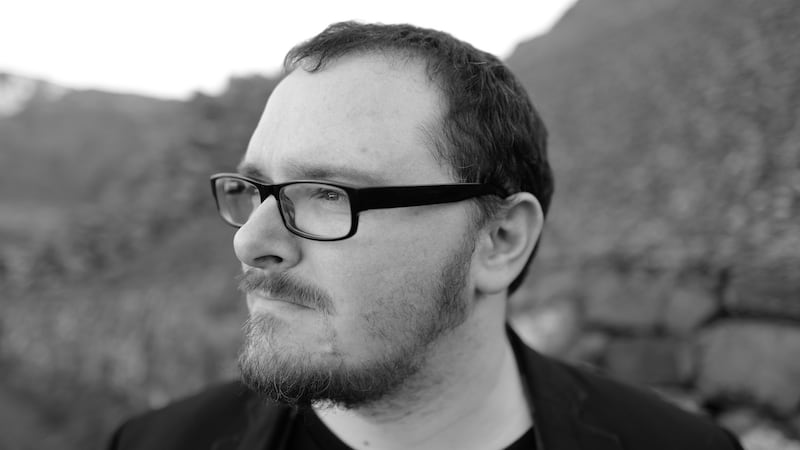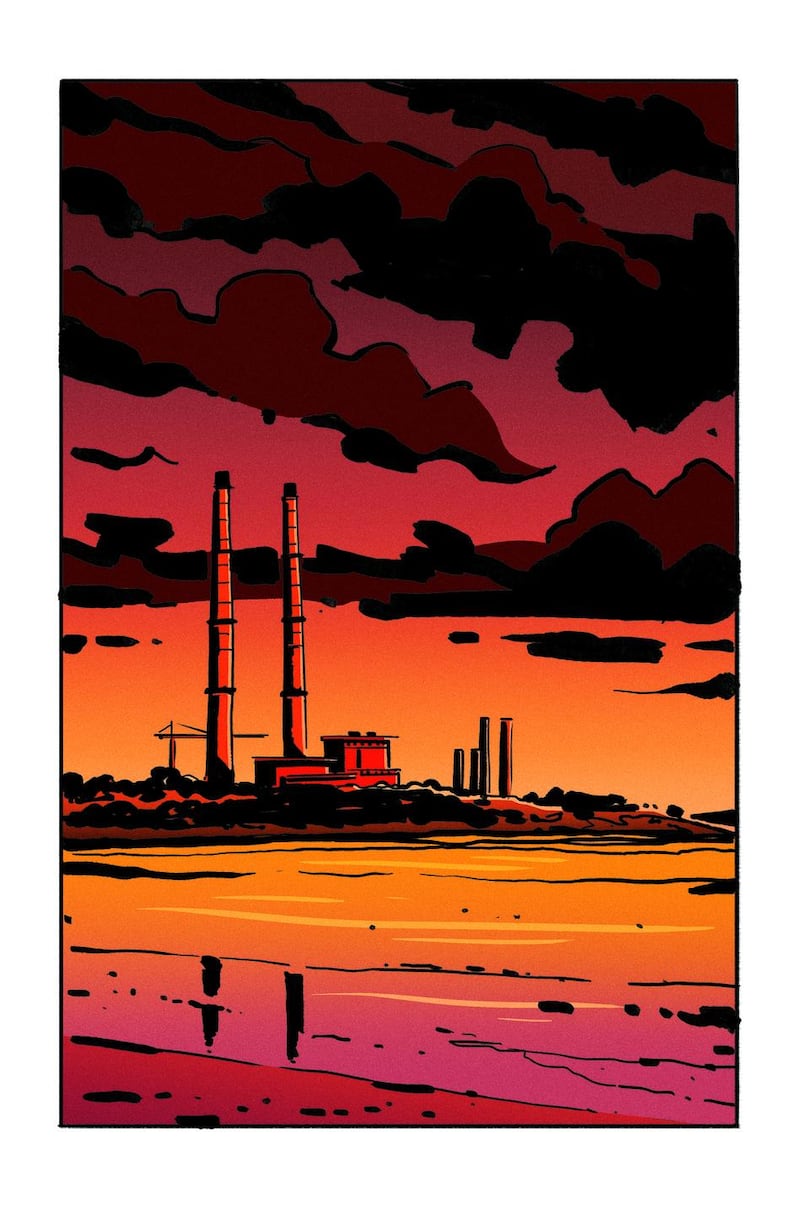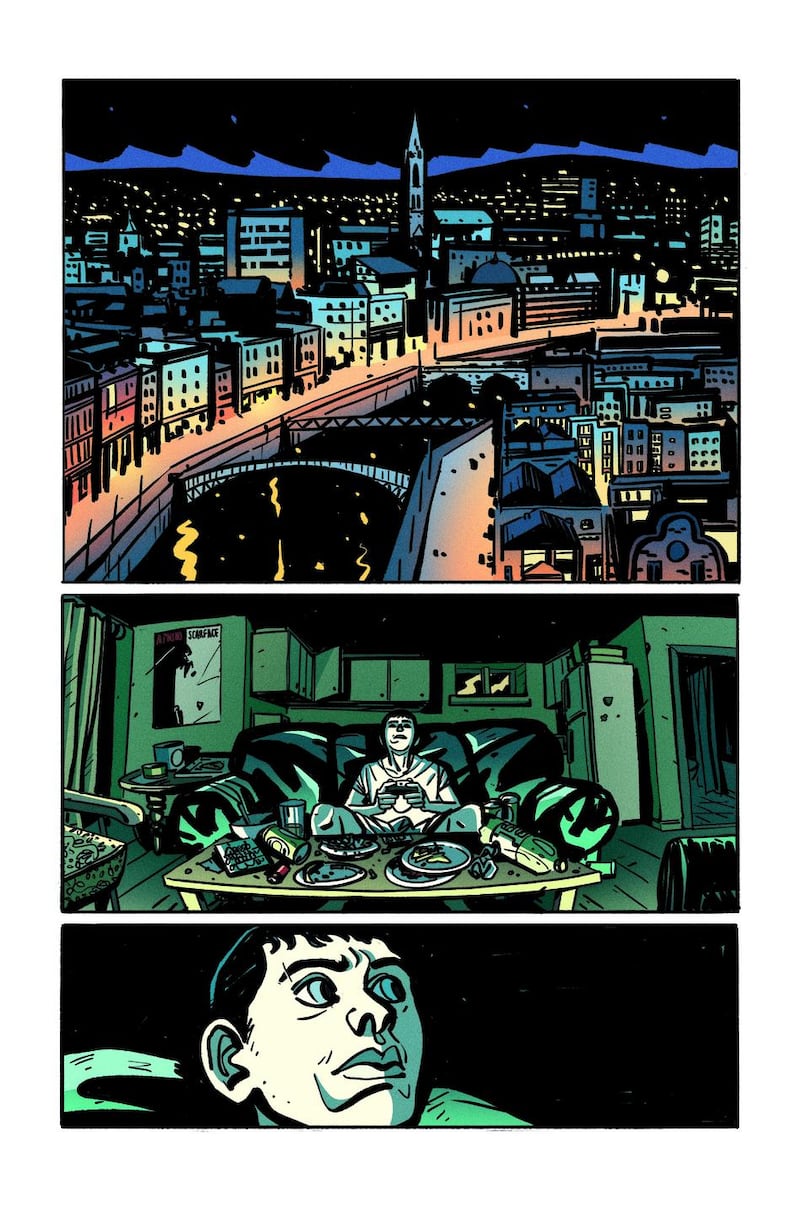On balance, Declan Shalvey seems undeterred by the lockdown. “In a way I feel bad,” he tells me via video conference from his flat in south Dublin. “I’m inside drawing all day, so I pretty much live a lockdown life anyway. It’s really affected me when I’ve had to order more paper and they’re not delivering; that’s when I’m reminded that the outside world is actually a thing.”
Part of that world is visible behind him, since his apartment is high enough to cast a view of the hills in which his newest graphic novel is set. That book, Bog Bodies, is a lean crime thriller that centres on a chase through the craggy briars and sodden turf of the Dublin mountains, following young hoodlum Killian in his attempts to escape a gangland hit gone wrong. Driven out to the spot where the gang’s bodies are disposed, he has to act quick to ensure he doesn’t join their slowly decaying population.
One of its inspirations, Shalvey tells me, was looking out at that foreboding slab of greenish-black from his window and thinking “Jesus, I’d hate to be stuck out there”.
Illustrated by Gavin Fullerton and coloured by Rebecca Nalty, Bog Bodies is a fully Irish-made noir that hangs on themes of vengeance and redemption.
“I wanted to tell two different stories,” he says. “A story of revenge from one point of view, and a story of forgiveness from another. Me and Gavin actually disagree about which way the story is; but I like that it can be both.”
The story fizzes with black humour and local flourish, and its dialogue hums with the knotty cadences of Dublin speech. The effect is arresting for anyone who’s read comics for decades, without ever seeing one open with headlines from the Six One news. “Originally, I had it written word-for-word,” he tells me. “I wrote exactly what they say on the Six One. But I have an American editor and she’ll catch stuff which is…” pause, “...too Irish”.

Given that Bog Bodies is released via US indie giant Image Comics, home to such properties as Spawn, The Walking Dead and Saga, I ask if he felt much pressure to “de-localise” it.
“Not really,” he says. “The great thing with Image is they let you do what you want. But I also don’t want people staring at the words for too long trying to make sense of them.”
‘It’s punctuation’
A great deal of the book’s local flavour comes from the colourfully robust language deployed by pretty much every character, another issue on which he stood his ground. “The editor did say at one point, ‘you’re using the word ‘f**k’ so much, it’s not having an impact any more’. I was like ‘oh, that’s fine – Irish people don’t use it for impact, it’s punctuation’.”
Beyond realism, Shalvey had a deeper reasoning for preserving the lingo.
“I think audiences are smarter than we give them credit for,” he says. “I remember watching the first season of The Wire, and I didn’t know what they were talking about. Not just the gangs and street slang, but the cops and their jargon. After a while, it starts to click and then it’s a more immersive element. That’s what I wanted to do with Savagetown specifically and also with Bog Bodies.”
Savagetown, Shalvey’s previous Irish-set work, was another gritty crime story about Limerick gangsters. His experience writing it with artist Philip Barrett and colourist Jordie Bellaire assured him of the capacity for homegrown storytelling. It also, crucially, proved he could get these kinds of stories made with big publishers.
“Bog Bodies was born out of Savagetown,” he says. “I’d worked with Image on [high-concept sci-fi hit] Injection with Warren Ellis. We did three volumes of that, so I’d proved to Image that I was reliable. A lot of people would pitch something but never get it made. I’d proved I could get it made. Originally, I was thinking it would be a trilogy, and the idea was that the Irish gang was the Irish economy and its speculation rises and everything falls apart. I thought ‘dammit Shalvey, you’re a genius!’”

Alas, this multi-chapter arc was not to be. “The book did well, but not well enough to warrant a sequel. So I figured: what if I tried something a bit shorter and cheaper? That was my pitch – try it again but different. Lower page count, and I’ll do the cover this time, cos I’m known for doing covers.”
Alongside blockbuster work on Moon Knight and Injection, Shalvey has spent a decade rising through comics’ ranks, illustrating titles like Thunderbolts and Deadpool and drawing more than 100 covers for Marvel alone. In a rare landmark for Irish artists, Marvel published a monograph collecting his work for the comics behemoth in January.
How then, I ask, does he decide which stories he draws, and which he writes? “The stuff that pays money, I draw,” he replies, with smiling candour. “With Savagetown or Bog Bodies, I can dip my toe into experimenting, and not risk losing my shirt, and also put a spotlight on Irish creators that people might not know about.
“Phil [Barrett, artist on Savagetown] is one of the best artists in the country, and I wanted to read a Phil Barrett graphic novel, so I wrote one. Same with Gavin Fullerton, he is such a great talent that I reckoned, I’d write something, he’d draw it, and we can both benefit. It was an artistic choice but a financial one too.”
Irish myth and language
The wellspring of Irish creators in comics has been a feature of the past decade. “Comics are lousy with the Irish now,” he laughs, “we’re like rats.”
It’s a far cry cry from the past, when references to Ireland and the Irish were limited to odd mentions and incongruous representations. These ran the gamut from the respectable, like Mike Mignola’s canny mining of Irish myth and language for his Hellboy series, to the ridiculous, such as the odd circumstances which led to Wolverine’s real name (Logan) being revealed to readers of X-Men #103 by a living, breathing leprechaun.
“I seem to remember they actually had good Irish names,” he says when I mention the latter. “There was a Padraic and I think there was a Séamus, so they did the research to get real names – just not enough to learn there were no leprechauns.
“I remember reading Preacher when I was a kid and working out that Garth Ennis was Irish and thinking, if he can do it then I can too. He’s from a housing estate in Belfast, I was from a housing estate in Clare, so maybe it’s not just a mad, crazy idea. I think there being more visible Irish creators was more encouraging to the next generation.

“Some of us about 10 years ago formed a friend group and we all supported each other and as we did better in the industry, more have come up afterwards. It’s great to see that there’s a thriving scene here and we’re all supportive of each other. I remember a British friend of mine saying ‘this doesn’t happen in the UK – we don’t help each other out!’”
Writers, artists and colourists currently propelling through the industry include Stephen Mooney, Dearbhla Kelly, Nick Roche, Stephen Thompson, Chris O’Halloran, Ruth Redmond, Will Sliney, Rory McConville, PJ Holden and Stephen Byrne, with most balancing high-profile work for traditional titans of the industry – DC, Marvel, Image, 2000AD – alongside smaller, creator-owned works that showcase the full span of comics’ storytelling range. Shalvey still saw gaps in the market, however.
“I was doing lots of superhero comics,” he says, “and I was watching The Snapper. I loved that movie as a kid, I just remember thinking – there’s nothing like that in comics. I wanted to write something my uncle would read. I was doing stuff with Warren Ellis who does that type of literary comic that I love, but I wanted to see something from my own background too.
“I’m aware there’s not an urgent push for a straight white guy to tell his story but I still think there’s something different and original about an Irish, working class upbringing.
“Bog Bodies isn’t The Snapper, but it’s a way of telling that kind of story but wrapping it in genre, in this case crime. I wanted to do a book that’s not just set in Ireland but is about Ireland in a broader kind of way. There’s things I love and hate about Ireland. I want them both in there.”











